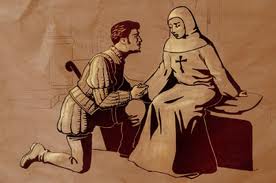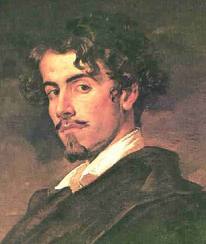Spanish Literature of the Romanticism
Insofar as Ramón de la Cruz moved away from the sophistication of courtly drama in order to come closer to the popular sentiment of his time, he became a precursor of Spanish Romanticism. In this sense, his sainetes and his one zarzuela preempt the enormous rise in popularity that the latter genre would enjoy in the XIX century through the emergence of costumbrismo.

Spread across Europe, especially over the German states and England, from the last quarter of the XVIII century onwards, Romanticism was a movement that transcended the barriers of the artistic, even of the cultural, to reach deep into the confines of the collective consciousness. In this respect, it could be said that Romanticism, more than any other category in art or social history, embodied the zeitgeist - the spirit of the times.
Romantic artists of reference, from Samuel Coleridge to Heinrich von Kleist and back again to Lord Byron, often lived tormented lives, deeply marked by intense emotions and cut short by malady or insanity in a bitter twist that enacted, as it were, the ultimate consequences of their aesthetic convictions: death, not as an artistic representation but as a tragic reality.
Like many of the tendencies to capture the imagination of writers in Europe after the Baroque, Spanish Romanticism arrived with a lag. It was not until well into the XIX century that Spanish audiences would be drawn towards a taste for the Romantic.
And yet, once it did strike, the Romantic syndrome struck with a vengeance. Once again immersed in a tragic war, the Spanish people were this time fighting for survival. The collective enemy, France, in the shape of the Bonapartes, triggered in the collective imaginary an irrepressible fondness for what was recognized as belonging to Spain, to the Spanish, to identity.
This might well have been the origin of the acquired taste for local habits and folklore, which flourished under the tag of costumbrismo. Side by side with this affinity came, too, a predilection for emotional characters, the elevation of the Imagination over Reason as the primary human faculty, and the constant and seemingly inevitable struggle between the two.
Spanish Romanticism was particularly felt on the dramatic productions of the time. As such, two names stand out among the writers of the time. The first of them is Juan Eugenio Hartzenbusch: born in Madrid in 1806, he became instantly famous with his first play, Los amantes de Teruel.

Hartzenbusch continued to explore typically nationalistic subjects, such as the legend of the Cid in La jura de Santa Gadea, and he appealed to the popular taste through many sainetes. However, his greatest contribution to Spanish and, indeed, world literature was perhaps his rediscovery of the work of Tirso de Molina, whose plays had been largely forgotten by the establishment in Spain.
Less concerned with costumbrismo yet equally aligned with the defining characteristics of the Spanish people was Jose Zorrilla, whose crowning achievement became an emblematic depiction of the Spanish prototype: Don Juan Tenorio, one of the most popular plays in the history of Spanish theatre, still often performed and studied in schools in Spain.
Addressing the contrast, and the ensuing tension, between the rash, heartless, macho and his sensitive fiancee, Doña Inés, Zorrilla lands upon one of the most popular topics of the Romanticism contributing his vision to the running argument that reaches all the way from Wordsworth and Coleridge's Lyrical Ballads to William Blake's mythological poems.
Gustavo Alofo Bécquer

Somewhat ironically, Spain's greatest Romantic writer would come when the movement was approaching its decadence, even in the country. Gustavo Adolfo Bécquer was born in 1838 in Seville, and would not publish his first poems before well into the 1850s. Though Bécquer published several volumes during his life, they were historical or epistolary, not lyrical.
Thus, it was only after his untimely death in 1870 that a comprehensive edition of his writing would be sent to the printers. The following year, the collected works of Gustavo Adolfo Bécquer was published: it was the birth of one of the most iconic works of Spanish literature, altogether - his Rimas y Leyendas (Rhymes and Legends). Spanish Romanticism was coming to an end with a bang, well into the era of Realism.
